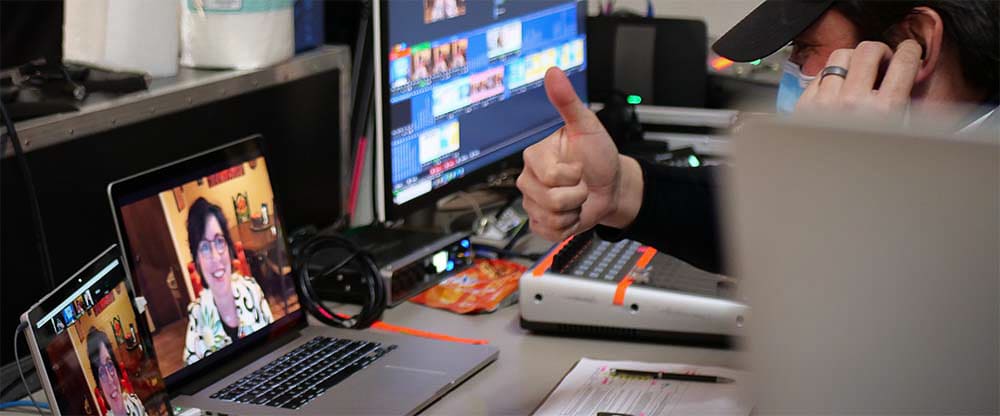Tech Tips for Remote Presenters

To be successful as a remote presenter—whether you’re a panelist or keynote speaker at a virtual, hybrid, or live event—your tech setup is crucial. When presenting remotely, you play a key role in the event’s technical execution. Follow these tech tips for remote presenters to ensure a smooth experience and stay focused on your message when it’s time to go live
Internet Connection
Your internet connection is arguably the most important part of your remote participation. If it goes down, no one can see or hear your presentation. Professional production studios use hardwired connections (CAT5 or CAT6 cables) to ensure reliability, and you can mimic this setup in your home or office.
- Best option: Plug directly into your router using an ethernet cable rather than relying on WiFi.
- Pro tip: Ask your AV team for adapter recommendations, as computer models vary.
If You Must Use WiFi From Your Home Office
If you can’t use a wired connection, take steps to improve your WiFi reliability:
- Ask others in your home to pause high-bandwidth activities (e.g. streaming, gaming, large file uploads) during your session.
- Position yourself close to your router to maximize signal strength.
Test Your Internet Speed
Check your internet speed at fast.com or search for “speed test” online. These tests give you approximate download and upload speeds. As a remote presenter, you are sending your internet feed TO the AV production team, so upload speed matters most.
- Pro tip: 10+mbps upload speed is the minimum we recommend.
Equipment Setup
Use the best available computer and close unnecessary applications during your presentation. Your setup will be an extension of the production studio, so give consideration to camera, microphone, and lighting placement.
- Pro tip: Ensure all devices are plugged in, fully charged, or have fresh batteries installed.
Lighting
Your webcam will adjust itself to the brightest light source in view. Make sure the light in front of your face is brighter than any light behind you.
- Use natural light or supplement with a ring light or clip-on light.
- Avoid overhead or backlighting, which can cause you to appear in shadow.
Read more about lighting, backgrounds, and framing yourself on camera in our article How to Film Yourself for Streaming.
Audio
Wear headphones or earbuds for the best experience as a remote presenter. Most video calling systems have built in echo cancellation, but it’s best not to rely on it. Echoes result in feedback loops or audio ducking (when everyone is talking at once, the software adjusts, and no one can hear each other).
Pro tip: If using wireless headphones, fully charge them before the event.
Give Yourself Enough Time
Nearly all technical problems experienced by remote presenters can be avoided if you allow yourself enough time to set up and test your equipment and connection. You don’t want to find out five minutes before going live that your internet connection is bad, or your room is too dark for the audience to see your face.
Be sure to call in at the time your AV production team has requested. This allows time to make necessary adjustments. During tech checks, our live stream production team at The AV Department tests all aspects of remote talent setups such as sound level/tone, camera framing, lighting, and internet connection. We also include time for remote guests to chat with each other in the virtual green room so that everyone feels comfortable. Don’t shortchange yourself and your co-panelists by calling in at the last minute before going live.
Pro tip: During the tech check, use the same devices in the same location as you will use during the event.
Final Preparations
Beyond technology, keep these presentation tips in mind:
- Look directly into the camera to engage your audience.
- Speak at at moderate pace.
- Ensure slides are easy to read with large font and minimal text.
Now you’re ready to go live! Whether participating in a fully virtual conference, joining a hybrid panel, or participating remotely in an in-person event, these tech tips will help you deliver a professional presentation your audience will appreciate.
Originally published September 2021. Updated March 20, 2025



